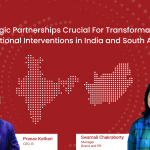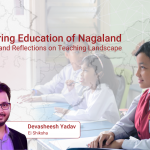- September 11, 2023
- by Chaitanya Kolluri, Senior Academic Consultant, Ei
- Blog
- 0 Comments
Building lesson plans – Using Competency focused questions and assessment data
Decision making-A data driven process
What is common between Google, Amazon and Netflix? Apart from being corporate giants in their respective domains, the everyday decision making of these companies is based on data. Google has created a People Analytics Department that supports HR to make decisions using data. Netflix decides its next distribution based on data collected from its users. Airlines and E-commerce make extensive use of data to personalize choices and suggestions. The medical field is heavily reliant on data coming from research and testing. Although informal and sometimes unorganized, everyday decisions like buying vegetables are based on data collection at an individual level.
In short, the world has moved on to data-driven decision-making. Decision-making that is backed by evidence can be very credible. Surely, education should not be any different.
While we have seen assessments using and giving data extensively, classroom transactions like lesson planning too can be data driven. In fact, the reliability of achieving learning outcomes will be far greater if teachers can support their experience and expertise with data.
Data driven teaching learning
While writing well defined learning objectives is an important part of the lesson planning process, giving the objectives a numerical face can yield a lot of powerful insights. The following chart summarizes this thought. The two-part illustrations further show how data can help enhance the lesson planning process.

Source: Strategies for Effective Lesson Planning by Stiliana Milkova
Center for Research on Learning and Teaching-University of Michigan
Part I: Questions that measure learning objectives
An important exercise in checking for student understanding is employing good questions that test the core competencies involved in the learning objective. We will now look at a part of a sample lesson plan for the topic Perimeter in Class 4.

Data from skill-based assessments suggests that a significant percentage of students have misconceptions about Perimeter. The following question is one such example.


 Source: Ei ASSET
Source: Ei ASSET
**Ei ASSET is a skill-based assessment that evaluates a student’s level of understanding by asking unfamiliar and thought-provoking questions that assess a student’s basic understanding of essential concepts.**
The question has a very specific objective of testing the understanding of Perimeter. 45% of the student sample actually believes that Shape 3 has a perimeter. If this question were to be incorporated in the lesson plan above as a metric of how well students can define Perimeter, it would yield a result for the teacher to intervene at the teaching learning stage itself.
The data thus obtained can be incorporated in the lesson plan as an additional feature. Lesson plan records like these can help decision-making while planning for the new academic year and otherwise.
The following table has a few more illustrations of how questions can serve as a metric for measuring learning objectives.
| Class | Objective | Questions | Observations |
| 3 | Identify/Define a Fraction |
| An indicator of how students are not clear with the notion of equal parts constituting Fractions. Teachers can incorporate this while covering the lesson and during practice sessions. |
| 6 | Compare/Order Decimals |
| A clear illustration of how previous learning (whole numbers in this case) can sometimes lead to alternative understanding of concepts. |
| 8 | Factorize an Algebraic Expression |
| An example of how the meaning of terms becomes important. While option 1 is correct in value, it is not the factorized form. This question can indicate if the term factorize has been clearly understood by students. |
| 10 | Identify Similar Triangles |
| A fair proportion of students look at Similarity of Triangles in one orientation. This question encourages teachers to use multiple orientations of figures during practice sessions. |
Source: Questions from the Ei CARES assessment program
**Ei CARES is a customized assessment platform designed to help teachers identify gaps and act on them with empirical data. **
An important part of this process is having good questions. A common characteristic of all the questions illustrated above is that they clearly demonstrate student learning.
Mindspark, a personalized adaptive learning tool gives insights on concepts that need practice. This helps teachers focus on specific areas, a decision that teachers can take based on reliable data .

Source: Ei Mindspark Monthly Summary Report
Part II: Building lesson plans with assessment data
Assessment data can be a very effective tool to pre-empt misconceptions and learning difficulties based on learning trends. The following data points are an illustration of this.![]()
![]() Source: Ei CARES assessment scores conducted throughout the year
Source: Ei CARES assessment scores conducted throughout the year
Certain skills like Comparison and Ordering of Proper Fractions are a part of enduring learning. They begin, in this instance with basics in primary classes and keep building in subsequent classes. Assessment across classes in the same skill can give useful insights on the process of teaching learning of enduring skills.
From the data above, it is clear that
- Comparing and Ordering of Proper fractions with different denominators is a skill that needs attention.
- In Class 3, the learning difficulties in Fractions with same denominators are far lesser compared to different denominators.
- From class 3 to class 5, the progress in the skill of comparing fractions with different denominators is not very significant. The trend with same denominators is significantly better across the same set of classes. This suggests that if handled well at class 3, comparing Fractions with different denominators can show improvement in the succeeding grades as well.
- Questions where students have gone wrong in the mentioned topics can then be mapped to the lesson planning process illustrated above as indicators of learning. Each year, this list of questions recycles into the lesson plan, making the teaching learning process well informed and robust.
- A comprehensive learner’s record is available for the action of teachers, schools and parents to understand the handholding that each stakeholder can possibly offer in the student’s learning journey in specific skills and sub skills.
The department as a whole can use these trends to map, find, predict and pre-empt issues in connected topics. From Operations on Fractions to Quadratic Equations with Fractional coefficients, this data can keep refining lesson plans. A class 10 teacher can plan a chapter like Quadratic Equations with Fractional coefficients but pre-empt difficulties with fraction addition or subtraction. The eventual goal is to not try mastering class 6 topics in class 10 but bring the whole school learning process to a stage where such interventions will not be necessary and the department uses data to address learning gaps than relying on anecdotes.
Benefits of the exercise
- Planning is based on reliable evidence. This helps teachers establish goals for themselves and the classroom.
- The quality of instruction is enhanced multi fold as teaching learning will involve an exhaustive list of illustrations that pre-empt and clarify misconceptions in learning.
- Student understanding improves significantly. Remediation is used an active tool while teaching and not just as a post assessment exercise.
- Collaboration between teachers and students is enhanced as both parties look at questioning critically from many perspectives.
- Teachers enter a continuous cycle of questioning for data and data for questioning that prompts them to research as opposed to relying only on prescribed reference books.
Conclusion: As opposed to anecdotal planning, data driven teaching learning process has far more reliability with the possibility of real time intervention. Educators and School Leaders who take this into cognizance first can pave the way for the rest of the community to understand, learn and implement. The first step in this direction is to recognize and accept that one size doesn’t fit all in a classroom. This will build conviction into the process making it a fruitful exercise.







